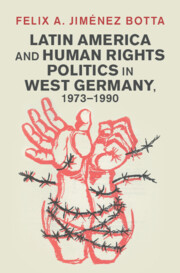Refine search
Actions for selected content:
3379599 results
List of Tables
-
- Book:
- Citizens to Traitors
- Published online:
- 15 July 2025
- Print publication:
- 04 September 2025, pp xi-xii
-
- Chapter
- Export citation
Index
-
- Book:
- The Story of a Sikh Museum
- Published online:
- 15 July 2025
- Print publication:
- 04 September 2025, pp 212-226
-
- Chapter
- Export citation
Part II - More than a Composer
-
- Book:
- Schoenberg in Context
- Published online:
- 04 September 2025
- Print publication:
- 04 September 2025, pp 49-96
-
- Chapter
- Export citation
Understanding Political Culture and Behaviour through Longitudinal Data in Alberta
-
- Journal:
- Canadian Journal of Political Science/Revue canadienne de science politique , First View
- Published online by Cambridge University Press:
- 04 September 2025, pp. 1-13
-
- Article
-
- You have access
- Open access
- HTML
- Export citation
Copyright page
-
- Book:
- Face and Form
- Published online:
- 21 August 2025
- Print publication:
- 04 September 2025, pp iv-iv
-
- Chapter
-
- You have access
- Open access
- HTML
- Export citation
Making friends with uncertainty: evaluation of a group intervention targeting intolerance of uncertainty in a Talking Therapies service
-
- Journal:
- The Cognitive Behaviour Therapist / Volume 18 / 2025
- Published online by Cambridge University Press:
- 04 September 2025, e43
-
- Article
-
- You have access
- Open access
- HTML
- Export citation
Chapter 1.5 - Conclusions of Part I
- from Part I - Consciousness
-
- Book:
- Near-Death Experiences
- Published online:
- 30 August 2025
- Print publication:
- 04 September 2025, pp 53-54
-
- Chapter
- Export citation
Chapter 1 - The Debates at Putney
-
- Book:
- The Social Contract
- Published online:
- 30 May 2025
- Print publication:
- 04 September 2025, pp 1-12
-
- Chapter
- Export citation
Chapter 14 - Rawls’s (Revised) Arguments
-
- Book:
- The Social Contract
- Published online:
- 30 May 2025
- Print publication:
- 04 September 2025, pp 178-191
-
- Chapter
- Export citation
Divided We Stand: The Legacy of Interwar Pan-European Debates in the Making of Socialist ‘Economists’ (1920s – Late 1950s)
-
- Journal:
- Contemporary European History , First View
- Published online by Cambridge University Press:
- 04 September 2025, pp. 1-18
-
- Article
-
- You have access
- Open access
- HTML
- Export citation
Figures
-
- Book:
- Love, Class and Empire
- Published online:
- 10 July 2025
- Print publication:
- 04 September 2025, pp viii-viii
-
- Chapter
- Export citation
Musical Examples
-
- Book:
- Schoenberg in Context
- Published online:
- 04 September 2025
- Print publication:
- 04 September 2025, pp xii-xii
-
- Chapter
- Export citation
Notes on Contributors
-
- Book:
- Schoenberg in Context
- Published online:
- 04 September 2025
- Print publication:
- 04 September 2025, pp xiii-xxii
-
- Chapter
- Export citation
Copyright page
-
- Book:
- Reassessing the Peloponnesian War
- Published online:
- 21 August 2025
- Print publication:
- 04 September 2025, pp iv-iv
-
- Chapter
- Export citation

Latin America and Human Rights Politics in West Germany, 1973–1990
- Coming soon
-
- Expected online publication date:
- September 2025
- Print publication:
- 18 September 2025
-
- Book
- Export citation
8 - What We Must Do
-
- Book:
- From Crisis to Action
- Published online:
- 15 August 2025
- Print publication:
- 04 September 2025, pp 176-207
-
- Chapter
-
- You have access
- Open access
- HTML
- Export citation
Music Examples
-
- Book:
- Anton Webern at the Dawn of Modernism
- Published online:
- 21 August 2025
- Print publication:
- 04 September 2025, pp xii-xiv
-
- Chapter
- Export citation
WHAT IS IT ABOUT VITAMINS? - VITAMINS AS INVESTIGATIVE KINDS
-
- Journal:
- Philosophy of Science / Accepted manuscript
- Published online by Cambridge University Press:
- 04 September 2025, pp. 1-25
-
- Article
-
- You have access
- Export citation
Contents
-
- Book:
- Maritime Relations
- Published online:
- 23 August 2025
- Print publication:
- 04 September 2025, pp vii-vii
-
- Chapter
- Export citation
9 - Skills Training, Migration and Employment: The Case of Raichur in Northern Karnataka
-
-
- Book:
- Shifting Landscapes
- Published online:
- 16 July 2025
- Print publication:
- 04 September 2025, pp 230-252
-
- Chapter
-
- You have access
- Open access
- Export citation
